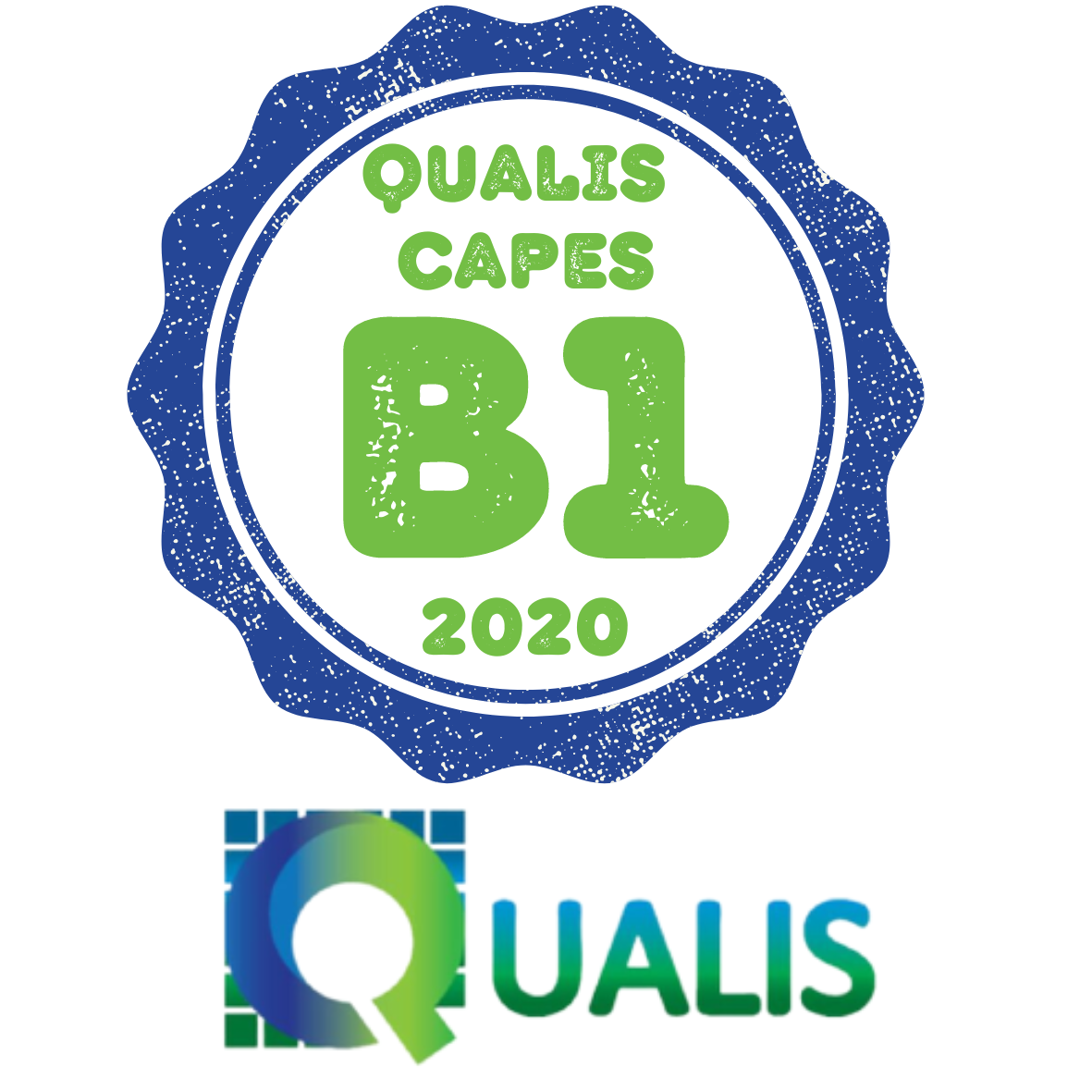EVIDÊNCIAS DE ESTRUTURA INTERNA DA ESCALA DE DEPENDÊNCIA DE EXERCÍCIO (EDS-R) NA POPULAÇÃO IDOSA
DOI:
https://doi.org/10.22289/2446-922X.V9N2A21Palavras-chave:
Idoso, PSICOMETRIA, instrumentos psicológicosResumo
Exercícios físicos são práticas benéficas para saúde e envelhecimento ativo, mas a prática excessiva, caracterizada como dependência do exercício, pode trazer efeitos deletérios a saúde dos praticantes. A dependência do exercício se configura quando o indivíduo prioriza a prática sistemática de exercícios, de qualquer natureza, em detrimento de outras atividades diárias. Um dos desafios é mensurar essa dependência do exercício. Desta forma, o objetivo do estudo é buscar evidências de validade da Escala de Dependência de Exercício (EDS-R) para a população idosa. Participaram do estudo 87 idosos (idade média = 65,89; dp = 4,79 anos). O recrutamento dos idosos foi realizado por redes sociais e aplicação do instrumento foi realizado de modo on-line. Para as evidências de estrutura interna foi utilizada a Análise Fatorial Confirmatória com estimador de Máximo Verossimilhança. A confiabilidade feita pelo alpha e ômega. Os resultados mostram adequação da estrutura fatorial com as cargas fatoriais oscilando entre 0,51 e 0,91, sendo os valores preditivos dos itens entre 0,26 a 0,83. Confiabilidade adequada com alfa = 0,90 e ômega =0,91. Os resultados apontaram para evidências de validade da estrutura interna do EDS-R e a viabilidade de seu uso para idosos.
Downloads
Referências
Alcaraz-Ibáñez, M., Sicilia, Á., Dumitru, D. C., Paterna, A., & Griffiths, M. D. (2019). Examining the relationship between fitness-related self-conscious emotions, disordered eating symptoms, and morbid exercise behavior: An exploratory study. Journal of Behavioral Addictions, 8(3), 603–612. https://doi.org/10.1556/2006.8.2019.43
Alchieri, J. C., Gouveia, V. V., Oliveira, I. C. V. de, Medeiros, E. D. de, Grangeiro, A. S. de M., & Silva, C. F. de L. S. da. (2015). Exercise Dependence Scale: adaptação e evidências de validade e precisão. Jornal Brasileiro de Psiquiatria, 64(4), 280–287. https://doi.org/10.1590/0047-2085000000090
Allegre, B., & Therme, P. (2008). Étude confirmative de l’échelle de dépendance à l’activité physique Exercise Dependence Scale-Revised pour une population francophone. L’Encéphale, 34(5), 490–495. https://doi.org/10.1016/j.encep.2007.08.004
Borsboom, D., & Mellenbergh, G. J. (2007). Test validity in cognitive assessment. Cognitive diagnostic assessment for education: Theory and applications, 85-115. https://doi.org/10.1017/CBO9780511611186.004
Brosof, L. C., Williams, B. M., & Levinson, C. A. (2020). Exploring the contribution of exercise dependence to eating disorder symptoms. International Journal of Eating Disorders, 53(1), 123–127. https://doi.org/10.1002/eat.23156
Carvalho, L., & Rebustini, F. (2023). Running and active aging: a mixed study on the reasons for practice, lifestyle and performance: Corrida e envelhecimento ativo: um estudo misto sobre os motivos de prática, estilo de vida e desempenho. Concilium, 23. DOI: 10.53660/CLM-2012-23N67
Cepellos, V. M. (2021). Feminização do envelhecimento: um fenômeno multifacetado muito além dos números. Revista de Administração de Empresas, 61(2). https://doi.org/10.1590/s0034-759020210208
Cordes, T., Bischoff, L. L., Schoene, D., Schott, N., Voelcker-Rehage, C., Meixner, C., Appelles, L.-M., Bebenek, M., Berwinkel, A., Hildebrand, C., Jöllenbeck, T., Johnen, B., Kemmler, W., Klotzbier, T., Korbus, H., Rudisch, J., Vogt, L., Weigelt, M., Wittelsberger, R., … Wollesen, B. (2019). A multicomponent exercise intervention to improve physical functioning, cognition and psychosocial well-being in elderly nursing home residents: a study protocol of a randomized controlled trial in the PROCARE (prevention and occupational health in long-term care) project. BMC Geriatrics, 19(1), 369. https://doi.org/10.1186/s12877-019-1386-6
Cronbach, L.J. Coefficient alpha and the internal structure of tests. Psychometrika 16, 297–334 (1951). https://doi.org/10.1007/BF02310555
Costa, S., Cuzzocrea, F., Hausenblas, H. A., Larcan, R., & Oliva, P. (2012). Psychometric examination and factorial validity of the Exercise Dependence Scale-Revised in Italian exercisers. Journal of Behavioral Addictions, 1(4), 186–190. https://doi.org/10.1556/JBA.1.2012.009
Downs, D. S., Hausenblas, H. A., & Nigg, C. R. (2004). Factorial Validity and Psychometric Examination of the Exercise Dependence Scale-Revised. Measurement in Physical Education and Exercise Science, 8(4), 183–201. https://doi.org/10.1207/s15327841mpee0804_1
Dunn, T. J., Baguley, T., & Brunsden, V. (2014). From alpha to omega: a practical solution to the pervasive problem of internal consistency estimation. British journal of psychology (London, England : 1953), 105(3), 399–412. https://doi.org/10.1111/bjop.12046
Furr, R. M. (2021). Psychometrics: an introduction. SAGE publications.
Gifford, J. R., & Collins, J. (2021). Critical Speed throughout Aging: Insight into the World Masters Championships. Medicine & Science in Sports & Exercise, 53(3), 524–533. https://doi.org/10.1249/MSS.0000000000002501
Granziol, U., Zorzi, A., Cardaioli, F., Cipriani, A., D’Ascenzi, F., Firth, J., Stubbs, B., Trott, M., & Solmi, M. (2021). Exercise addiction in athletes: Comparing two assessment instruments and willingness to stop exercise after medical advice. Psychological Assessment, 33(4), 326–337. https://doi.org/10.1037/pas0000987
Kern, L. (2010). Relation entre la dépendance à l’exercice physique et les cinq dimensions de la personnalité. L’Encéphale, 36(3), 212–218. https://doi.org/10.1016/j.encep.2009.06.007
Kuan, M., Muller F., Fang, Y., Fung, H.H., Lang, F.R (2016). Taking Diversity into Account Assessment of Older Adults em: Leong, F. T., Bartram, D., Cheung, F., Geisinger, K. F., & Iliescu, D., The ITC international handbook of testing and assessment, 290-299. https://doi.org/10.1093/med:psych/9780199356942.003.0020
Leive, A. (2018). Dying to win? Olympic Gold medals and longevity. Journal of Health Economics, 61, 193–204. https://doi.org/10.1016/j.jhealeco.2018.07.005
Lepers, R., Stapley, P. J., & Cattagni, T. (2016). Centenarian athletes: Examples of ultimate human performance? Age and Ageing, 45(5), 729–733. https://doi.org/10.1093/ageing/afw111
Levit, M., Weinstein, A., Weinstein, Y., Tzur-Bitan, D., & Weinstein, A. (2018). A study on the relationship between exercise addiction, abnormal eating attitudes, anxiety and depression among athletes in Israel. Journal of Behavioral Addictions, 7(3), 800–805. https://doi.org/10.1556/2006.7.2018.83
McDonald R. P. (1999). Test theory: A unified treatment. Mahwah, NJ: Lawrence Erlbaum
McNeish D. (2018). Thanks coefficient alpha, we'll take it from here. Psychological methods, 23(3), 412–433. https://doi.org/10.1037/met0000144
Martín-Guzón, I., Muñoz, A., Lorenzo-Calvo, J., Muriarte, D., Marquina, M., & de la Rubia, A. (2021). Injury Prevalence of the Lower Limbs in Handball Players: A Systematic Review. International Journal of Environmental Research and Public Health, 19(1), 332. https://doi.org/10.3390/ijerph19010332
Maximiano-Barreto, M. A., Andrade, L., Campos, L. B. de, Portes, F. A., & Generoso, F. K. (2019). A feminização da velhice: uma abordagem biopsicossocial do fenômeno. Interfaces Científicas - Humanas e Sociais, 8(2), 239–252. https://doi.org/10.17564/2316-3801.2019v8n2p239-252
Morgan, W. P. (1979). Negative addiction in runners. Physician and Sportsmedicine, 7(2), 56–70. https://doi.org/10.1080/00913847.1979.11948436
Northey, J. M., Cherbuin, N., Pumpa, K. L., Smee, D. J., & Rattray, B. (2018). Exercise interventions for cognitive function in adults older than 50: a systematic review with meta-analysis. British Journal of Sports Medicine, 52(3), 154–160. https://doi.org/10.1136/bjsports-2016-096587
Palazzolo, J. (2020). Anxiety and performance. L’Encéphale, 46(2), 158–161. https://doi.org/10.1016/j.encep.2019.07.008
Prieto-Lage, I., Argibay-González, J. C., Paramés-González, A., Pichel-Represas, A., Bermúdez-Fernández, D., & Gutiérrez-Santiago, A. (2021). Patterns of Injury in the Spanish Football League Players. International Journal of Environmental Research and Public Health, 19(1), 252. https://doi.org/10.3390/ijerph19010252
Rebustini, F., Balbinotti, M. A. A., de Lucena Ferretti-Rebustini, R. E., & Machado, A. A. (2016). Psicometria esportiva, caracterização dos participantes e invariância. Journal of Physical Education, 27(1), e-2760. https://periodicos.uem.br/ojs/index.php/RevEducFis/article/view/30635
Rogers, M. L., Duffy, M. E., Buchman-Schmitt, J. M., Datoc, A. E., & Joiner, T. E. (2019). Exercise dependence: Associations with capability for suicide and past suicidal behavior. Journal of Clinical Psychology, 75(1), 165–177. https://doi.org/10.1002/jclp.22696
Shin, K., & You, S. (2015). Factorial Validity of the Korean Version of the Exercise Dependence Scale–Revised. Perceptual and Motor Skills, 121(3), 889–899. https://doi.org/10.2466/03.08.PMS.121c27x8
Sicilia, Á., & González-Cutre, D. (2011). Dependence and Physical Exercise: Spanish Validation of the Exercise Dependence Scale-Revised (EDS-R). The Spanish journal of psychology, 14(1), 421–431. https://doi.org/10.5209/rev_SJOP.2011.v14.n1.38
Sijtsma K. On the Use, the Misuse, and the Very Limited Usefulness of Cronbach's Alpha. Psychometrika. 2009 Mar;74(1):107-120. doi: 10.1007/s11336-008-9101-0. Epub 2008 Dec 11. PMID: 20037639; PMCID: PMC2792363.
Silva, V. S. da, Souza, I., Matos, D. I. de, Pires, R. S., & Maciel, M. C. (2020). Um ensaio sobre a questão racial no esporte. Motrivivência, 32(63), 01–17. https://doi.org/10.5007/2175-8042.2020e74139
Stenseth, O. M. R., Barli, S. F., Martin, R. K., & Engebretsen, L. (2022). Injuries in elite women’s ski jumping: a cohort study following three International Ski Federation (FIS) World Cup seasons from 2017–2018 to 2019–2020. British Journal of Sports Medicine, 56(1), 35–40. https://doi.org/10.1136/bjsports-2021-104198
Trapé, Á. A., Marques, R. F. R., Lizzi, E. A. da S., Yoshimura, F. E., Franco, L. J., & Zago, A. S. (2017). Associação entre condições demográficas e socioeconômicas com a prática de exercícios e aptidão física em participantes de projetos comunitários com idade acima de 50 anos em Ribeirão Preto, São Paulo. Revista Brasileira de Epidemiologia, 20(2), 355–367. https://doi.org/10.1590/1980-5497201700020015
Toots, A., Littbrand, H., Lindelöf, N., Wiklund, R., Holmberg, H., Nordström, P., Lundin?Olsson, L., Gustafson, Y., & Rosendahl, E. (2016). Effects of a High?Intensity Functional Exercise Program on Dependence in Activities of Daily Living and Balance in Older Adults with Dementia. Journal of the American Geriatrics Society, 64(1), 55–64. https://doi.org/10.1111/jgs.13880
Veale, D. M. W. de C. (1987). Exercise and mental health. Acta Psychiatrica Scandinavica, 76(2), 113–120. https://doi.org/10.1111/j.1600-0447.1987.tb02872.x
Waldstreicher, J. (1985). ANOREXIA NERVOSA PRESENTING AS MORBID EXERCISING. The Lancet, 325(8435), 987. https://doi.org/10.1016/S0140-6736(85)91765-9
Yates, A., Leehey, K., & Shisslak, C. M. (1983). Running — An Analogue of Anorexia? New England Journal of Medicine, 308(5), 251–255. https://doi.org/10.1056/NEJM198302033080504
Zandonai, T., Manresa-Rocamora, A., Monese, L., Moya-Ramón, M., Schena, F., & Chiamulera, C. (2020). A descriptive study of exercise dependence: a short report among Italian and Japanese runners. Journal of Addictive Diseases, 39(1), 133–137. https://doi.org/10.1080/10550887.2020.1829450
Downloads
Publicado
Como Citar
Edição
Seção
Licença
Copyright (c) 2023 Psicologia e Saúde em debate

Este trabalho está licenciado sob uma licença Creative Commons Attribution-NonCommercial-NoDerivatives 4.0 International License.
Os autores declaram que participaram na elaboração do manuscrito em questão, e que o citado manuscrito é original e não foi previamente publicado em parte ou no todo e que nenhum outro manuscrito similar sob autoria dos mesmos está publicado ou em análise por outro periódico seja impresso ou eletrônico. Declaram ainda, que não violaram nem infringiram nenhum copyright ou nenhum outro tipo de direito de propriedade de outras pessoas, e que todas as citações no texto são fatos verdadeiros ou baseados em pesquisas de exatidão cientificamente considerável. Os autores comprometem, quando solicitado, a fornecer informações aos editores a respeito dos dados deste manuscrito.
A revista segue o padrão Creative Commons (BY NC ND), que permite o remixe, adaptação e criação de obras derivadas do original, mesmo para fins comerciais. As novas obras devem conter menção ao(s) autor(es) nos créditos. O site utiliza o Open Journal Systems, sistema de código livre gratuito para a administração e a publicação de revistas desenvolvido com suporte e distribuição pelo Public Knowledge Project sob a licença GNU General Public License.
































